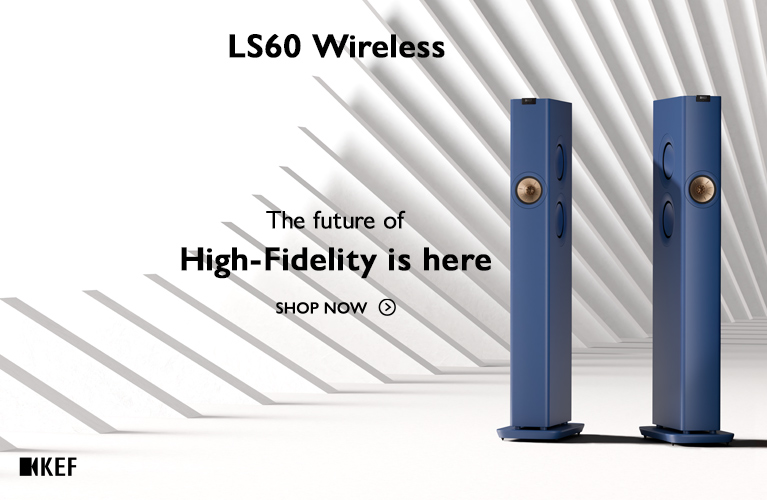Note: for the full suite of measurements from the SoundStage! Audio-Electronics Lab, click this link.
 Over the last while, I’ve learned to love large, solid-state amplifiers. This love affair started with my purchase of a Bryston 4B3, which I bought when I finally gave up on my aging Audio Research VT100 MkI tube amp. At the time I was somewhat depressed about the VT100’s departure, as tubes had always been a big part of my system; perhaps, even, of my identity. I loved the idea of tubes, and their sound—and I still do.
Over the last while, I’ve learned to love large, solid-state amplifiers. This love affair started with my purchase of a Bryston 4B3, which I bought when I finally gave up on my aging Audio Research VT100 MkI tube amp. At the time I was somewhat depressed about the VT100’s departure, as tubes had always been a big part of my system; perhaps, even, of my identity. I loved the idea of tubes, and their sound—and I still do.
But my VT100 was giving me grief. It kept frying tubes, and replacing them got expensive. Furthermore, I kept looking askance at the amp, second-guessing myself. Was it working properly with the speakers I had in for review? Would it electrocute the dog?
So I sort of gave in and (grumble) bought a solid-state amp. To tell the truth, I didn’t expect to enjoy it. But much to my surprise, I really did like listening to the Bryston. There wasn’t much of an acclimatization period, and the 4B3 has been sitting in my system for the last six years. I’ve come to appreciate the power and neutrality this type of beast delivers. In fact, I’ve started to crave bigger and better amplifiers of the breed.
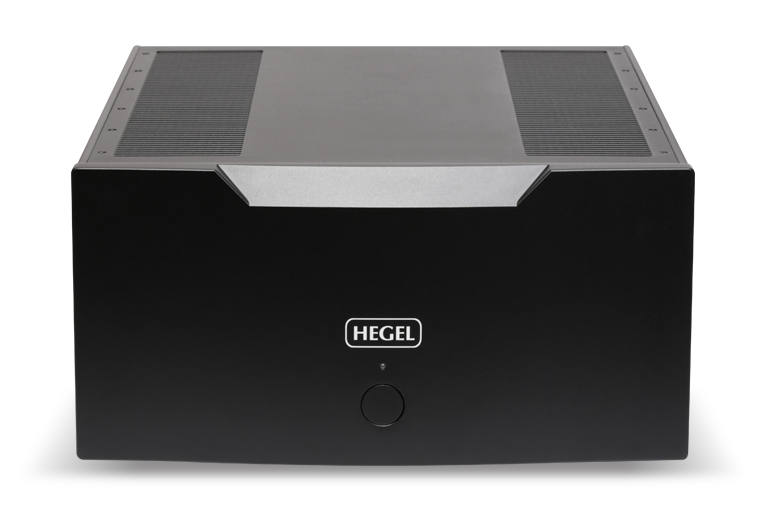
And here, in my system, right now, is the largest amplifier I’ve yet experienced: the Hegel Music Systems H30A, which replaces the company’s almost-as-large and now-discontinued H30. And my stars, is it big.
How big is it?
Priced at $19,000 (all prices in USD), the H30A is a seriously dense unit. I’ve cycled a number of heavy electronic components through my system, and I’ve always appreciated the reassurance that accompanies physical weight. That said, I can’t recall a single component that’s felt as purposeful as the H30A.
The H30A weighs in at 104.5 pounds, but a close look at the chassis reveals that the amp is not just an overbuilt carcass. Don’t get me wrong—the H30A is constructed to a very high standard, but it’s well built as opposed to overbuilt. The thick faceplate is milled from solid aluminum, and the side panels are fabricated from solid but not extravagantly massive aluminum. The top plate is sheet aluminum of reasonable thickness, and is somewhat under-damped.
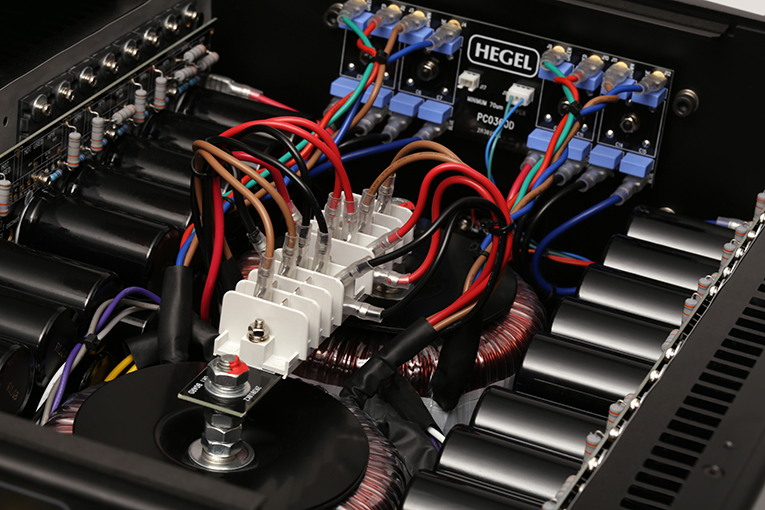
So the chassis itself doesn’t account for all that beef. What packs on the pounds is under the hood—the H30A’s dual 1000VA transformers and 270,000µF of filter capacitors. The H30A is essentially over-specified, and the end result seems to be an amplifier that can drive pretty much anything. I asked Anders Ertzeid, Hegel’s VP of sales and marketing, if there were any tricksy reasons why the H30A employs two transformers. Is it to enable dual-mono operation when the amp is used in stereo mode? Not really, Ertzeid replied. By using two slightly smaller transformers instead of a single gigantic one, the windings can be tighter, which minimizes transformer hum. A side benefit is a lower center of gravity for the amp, which decreases the risk of it tipping over during transportation.
Hegel states that the custom-made, high-current, low-impedance filter capacitors are installed very close to the power transistors to minimize series inductance. The H30A has 56 biploar power transistors, which are specified as 15A, 200W, high-speed, ultralow-distortion devices. The H30A’s circuitry features Hegel’s SoundEngine2 technology, which is a type of feed-forward error correction. According to Hegel, SoundEngine2 significantly reduces all types of distortion and dramatically improves dynamic range.
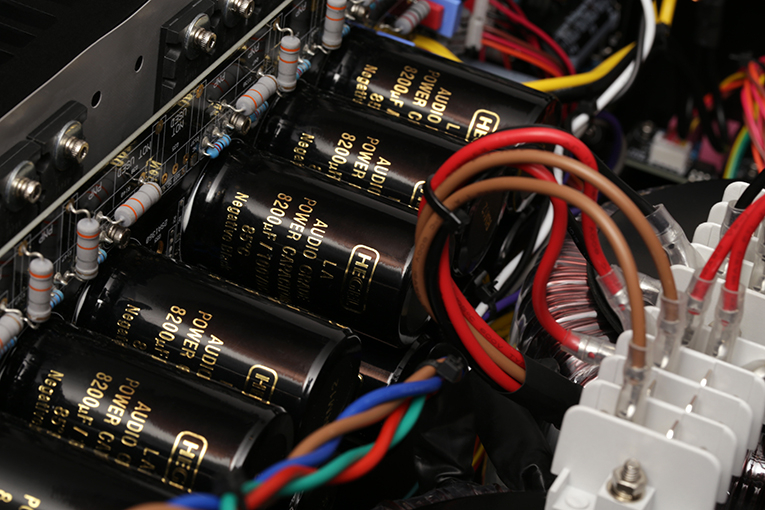
It’s important, but somewhat disorienting, to note that the H30A is designed first and foremost as a mono amplifier. In this configuration, Hegel specifies that the H30A will chug out 1100W into an 8-ohm load. Still looking at its monoblock credentials, the H30A is stated as stable into a 1-ohm load. That’s a punishing load. Hegel doesn’t specify power output when the H30A is used as a stereo amp—I pushed Ertzeid on this question, and he told me that Hegel would rather just say: “More than 300Wpc.” Fair enough.
Something’s got to give though. When used as a monoblock, the H30A is fully balanced. Flip it to stereo mode and now the H30A is single-ended. My system is configured to be fully balanced throughout, so using a single H30A in stereo mode with either Hegel’s matching P30A preamp, or my own Sonic Frontiers SFL-2, means I’m breaking that balanced chain. I suppose I could have asked Hegel to ship another H30A so I could use the pair of them as monoblocks, but that’s just plain silly. One of these amps provides more power than any sane person should require. That said, having the H30A on one side of my equipment rack left me looking askance at the other side–symmetry is important in this sport, eh?
Set me up
Perhaps the most notable logistical challenge of the H30A is its sheer fucking mass. There’s no easy way to get it (a) into the house, (b) out of the box, and (c) into whatever section of the room that’s appropriate for this monster.
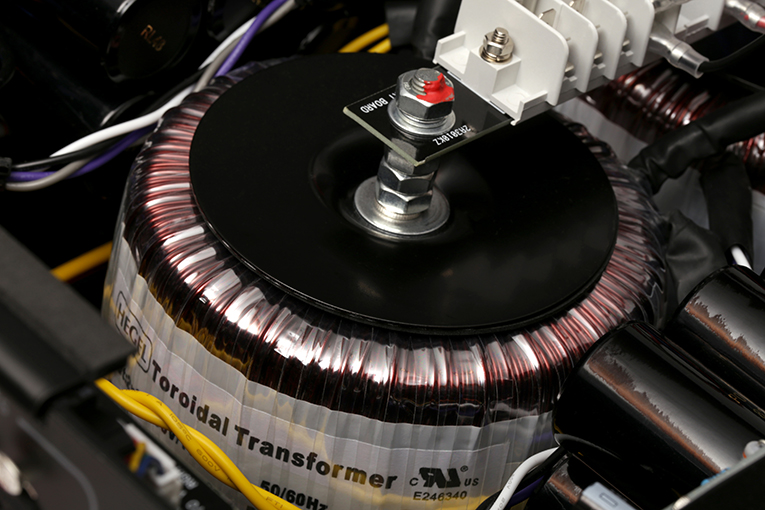
My rack doesn’t provide enough clearance for the H30A’s 9.4″ height. The amp’s 17″ width is manageable, but is there a rack on Earth that can accommodate an amplifier that’s nearly 26″ deep, with a couple of extra inches for power, input, and speaker cables? I doubt it. So I ignominiously stuffed the H30A on the floor in the right-front corner of my room, where it sat like a good boy for the duration of the review.
The moral of this story is that you need two fit people with no lower-back issues to move the H30A into position. Or you could just ask my neighbor Rob to stop by and deadlift it out of its carton like it was nothing. But he’s an edge case in more ways than one. My L3 vertebra thanks you, Rob.
Hookup around back is straightforward. For stereo usage, there are XLR and RCA inputs (selectable by toggle switches) for the left and right channels. In the center of the rear panel are another set of XLR and RCA inputs for mono usage, again selectable by toggle switch. There’s one more toggle switch to select mono or stereo mode. The binding posts are substantial and easy to grip, but as I was using banana-plug connections I didn’t have to mess with them.
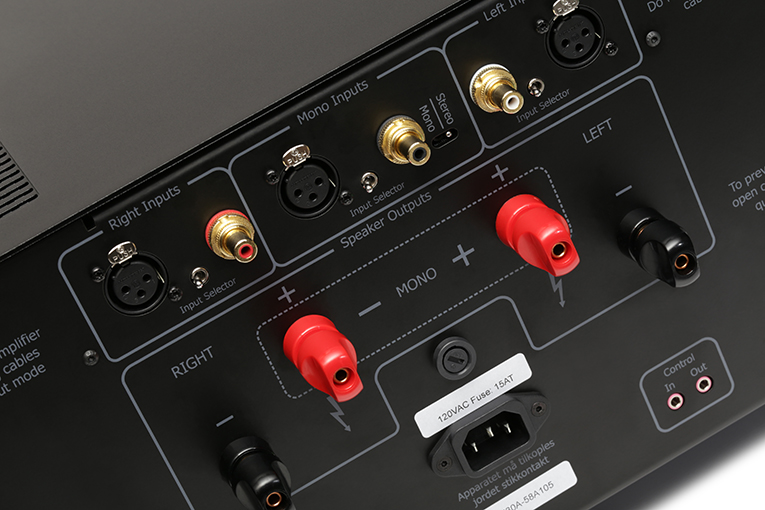
The power switch up front ignites the amp after a short warm-up delay. Functionally, the H30A didn’t so much as burp during its time in my house. I left it powered up all the time and it only ever got vaguely warm.
The H30A’s input sensitivity is quite high, and I used Hegel’s P30A preamp for most of this review. The P30A and H30A make a wonderful combo. Near the end of the review period, I swapped in my Sonic Frontiers SFL-2 preamp and discovered that I could only use the first four steps of the volume control. I asked Bent Holter, Hegel’s founder, about this. He responded:
From my experience, it is best for the best possible dynamic range to have 32dB gain in the power amp and a low gain in the preamp. I know this is not typical in America. They normally use 26dB gain in power amp and higher gain in preamp. But having a high gain in the line stage of the preamp and then damping the volume by setting the volume control at a low setting is not optimal. So we prefer higher gain in power amp, and less gain in preamp so the volume control can be set higher. So you should probably have a low-gain preamp (for example a Hegel P30A or similar) to experience the full potential of the H30A.
Plug me in
As you might expect, given the amp’s pedigree and Hegel’s engineering prowess, the H30A immediately presents as neutral, composed, and powerful. There’s nothing newsworthy about this. You should be able to say pretty much the same about any high-quality solid-state amplifier. Still, it needs to be said. In terms of tonal balance and general presentation, swapping out my Bryston 4B3 for the Hegel was essentially a nonevent.
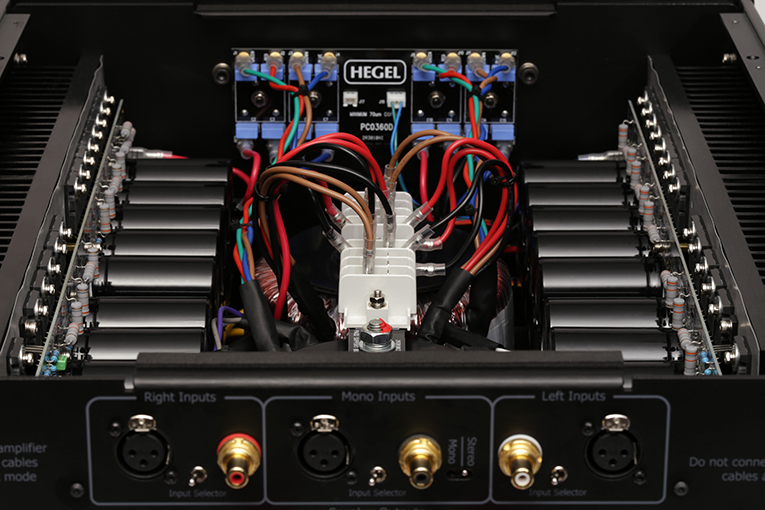
In size, price, and scale, the Hegel H30A is quite similar to the Simaudio Moon 860A v2, which I reviewed in November 2021. I recall spending a lot of time trying to identify sonic differences between the big Moon amplifier and my own Bryston 4B3. After a while, it became clear to me that the Simaudio was just slightly smoother through the upper midrange and treble than the Bryston. That certainly suited my tastes, given that I love vinyl and have a soft spot for tubes. Now, smoother didn’t really translate to better in that case. Perhaps it would be more accurate to say that the 860A v2 was slightly more reticent in the treble. There were other differences, and it was clear to me that the Simaudio was the superior amplifier, but initially it was the highs that jumped out at me.
Not so much with the Hegel H30A. The Hegel’s top end was clear and extended, without the Simaudio’s slight softening. I was able to settle down with the Hegel in my system without any of the jarring shifts in perception that new gear sometimes generates.
I know this may sound contradictory, but I’m in no way saying that the Bryston and the Hegel sounded the same. There are in fact huge differences—important, vital differences. The most striking and immediate characteristic of the H30A was its ability to produce huge, well-formed images. As with most well-made solid-state amplifiers of my experience, the H30A excelled with speed and dynamic snap, but that’s a given with this breed of component.
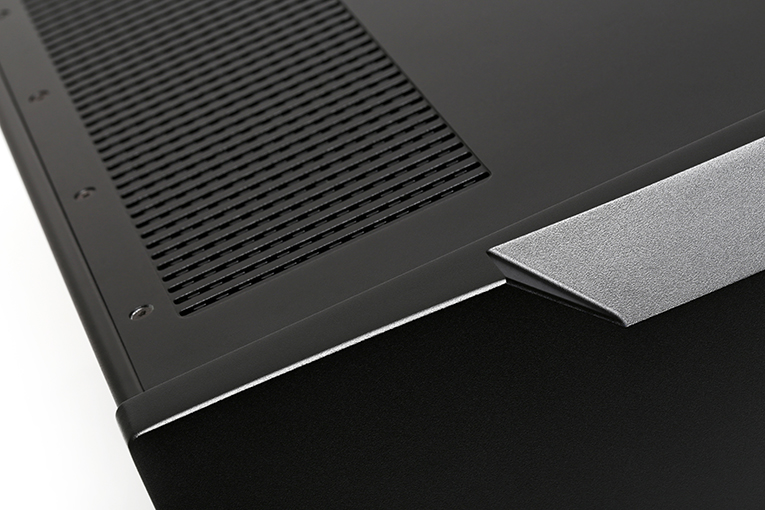
Where it got very interesting was down in the bass. I’m used to high-current, high-powered amplifiers gripping and controlling the low end, but I was not expecting the H30A to generate such big, meaty, corporeal images. In my worldview, a great amp-speaker combination produces bass that you can feel; bass that simulates a real-world instrument. And then your mind fills in the rest.
The simple swap to the Hegel amp dramatically changed how I heard bass instruments—especially acoustic ones. Near the beginning of the review period, I threw Piano in the Background by Duke Ellington and his Orchestra (LP, Columbia CS 8346) onto my VPI turntable. Right off the top, with the first few notes on “Happy Go Lucky Local,” I got whomped in the chest by Aaron Bell’s bass. At first, I thought the Hegel was just highlighting the bass frequencies, giving more current and control, or maybe just elevating that region a touch. But that wasn’t it. Rather, the Hegel seemed to project an actual instrument, physically correct in size, just to the right of center. Not, I might add, the impression of an acoustic bass. With the H30A taking control of the speakers, my system was now near-as-dammit letting me see the actual outline of the instrument. I know this sounds wonky, but I felt like I could sense the length of the strings in their entirety as they vibrated outward toward me.
“Kinda Dukish” whispers in, slinky and sexy-like. This track has Ellington’s unique sense of loping swing (something missing from all the other name-brand big bands). There’s lots of space around the bass, drums, and piano, but Bell’s whaling away at that string bass, and it takes a bit more of a front-row placement than you usually hear in a big band. “Kinda Dukish” turned me all around, so I played it repeatedly.
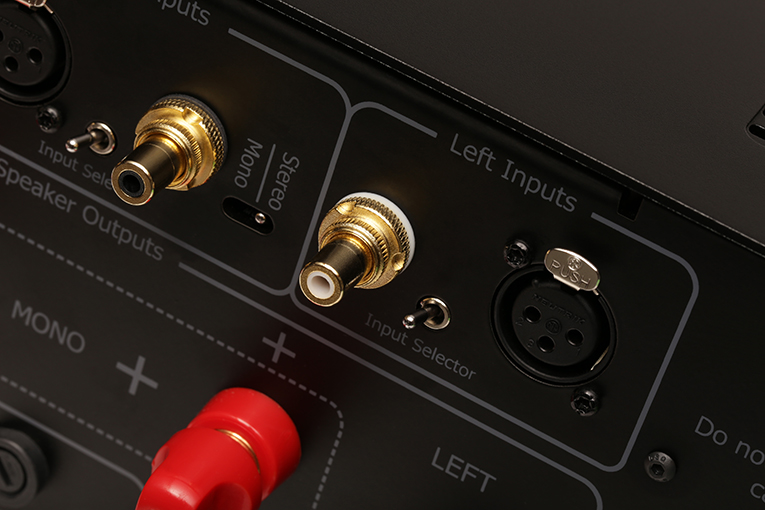
You might be tempted to write off this big-amp-does-big-bass attribute as something that defines all solid-state bruisers. That’d be a mistake, because the way the H30A renders bass frequencies carries over to other frequency ranges and other instruments.
There’s a crackling sense of power to the H30A’s rendering through the upper bass and into the midrange. A good example of this is the abrasive, distorted carrier-wave guitar that overlays “In Our Sleep” from Laurie Anderson’s Bright Red (LP, Music On Vinyl MOVLP2539); especially the way the guitar rides atop the huge, rolling bass notes. There are all kinds of nifty ambient effects going on in this track. It’s a dense recording: one that provides an opportunity for a great system to sort everything out—and conversely, gives weak components a chance to really mess things up.
The H30A gave a slight boost to the attack on that snappy guitar. Not tonally, I’ll reiterate, but more with placement in space, in solidity of image. The H30A didn’t just make it sound like a real guitar; the big Hegel made it feel like a real guitar. It’s like when you hear a sound that you don’t expect and you turn your head to look. Before you actually see the source of the sound, you already have a picture of it in your mind. Realistic sounds form visual images, and that’s what was going on here.
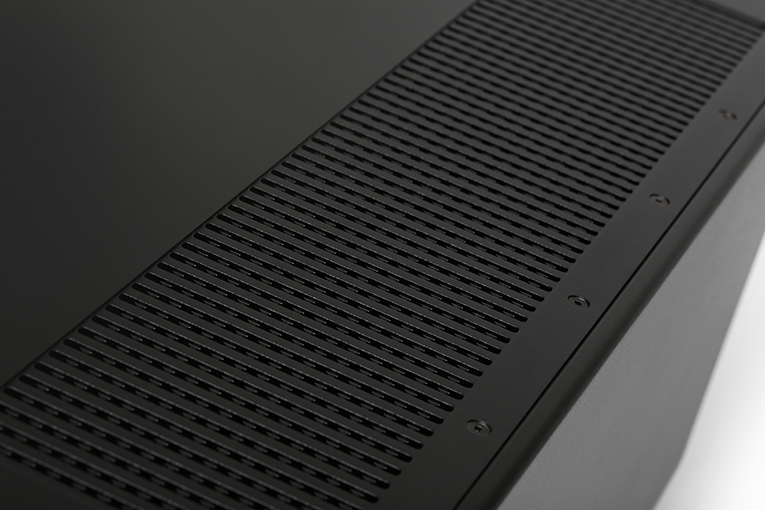
I guess my descriptions of how the H30A snapped instruments into focus segues into how the amp images in general. Well, image placement and soundstage depth are both handily accomplished by my Aurelia Cerica XL speakers, which throw out a huge wall of sound that projects outwards like a cone. It’s something of a parlor trick—one you have to hear to believe. The Hegel amplifier literally gripped my Aurelias, forming rock-solid images with astounding depth and focus. When I first threw Astor Piazzolla’s Tango: Zero Hour (LP, Pangea PAN-42138) onto the VPI, I almost wet myself. I’m not being dramatic—I already had to take a squirt, and I had a full beer in my hand. But right from the start, from “Tanguedia III,” I was riveted and had to listen right through to the end of the side. The piano that anchors the band, right in the center of the soundstage, was so solid, so vital, so real that it took my breath away. Likewise, the violin, which for the most part is a backing instrument, gained vital depth and a sense of woody roundness. So yeah, the H30A forms images unbelievably well.
Things are a bit more conventional at the top of the frequency range. The Hegel doesn’t sweeten the sound in any way, but it’s clear, free of any sense of grain, and true to the signal. There are tons of squeaky, high-pitched overtones on Piazzolla’s bandoneon, and on “Milonga del ángel,” the H30A got me right up front and close to the reeds. This old, thin LP is exceptionally well recorded, and delivers a clear window into the performance. At points, the highs can get the tiniest bit abrasive, especially when played at realistic levels, and the H30A didn’t tamp that down in any way. But I was easily able to listen through that nastiness, right into the heart of this terribly sad, beautiful music.
I want to dwell on that sadness, the feel, the sheer monstrous emotion of “Milonga del ángel,” and how it relates to stereo equipment. I could happily listen to this album in the shower, using a Bluetooth speaker propped up in the soap dish. But to get this music, to really, really get it, to understand what’s going on and find something new on each listen, my system has to be beyond reproach. With the H30A commanding my Aurelias, I got it. The H30A’s solidity of image allowed me to see inside the music and understand some of the more complicated transitions between the violin and bandoneon.
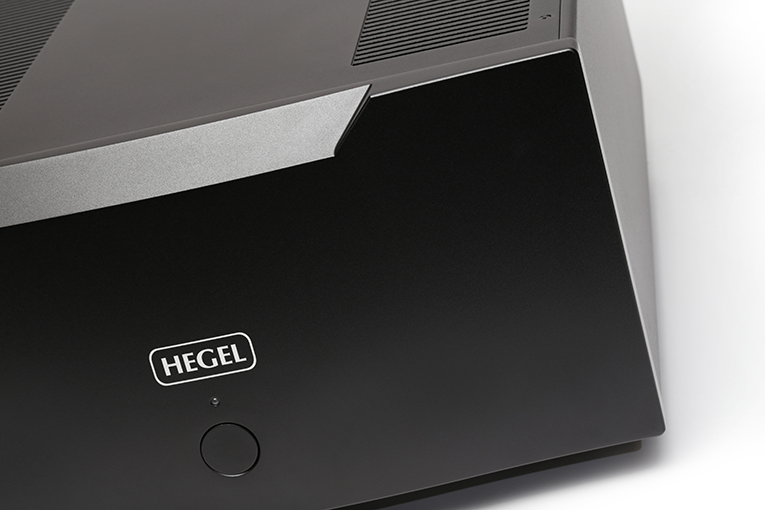
I generally try not to talk about how a component integrates into my system as a whole. I feel it’s more useful to impart the isolated sound of that component, and how you might expect it would perform in your system. But this time I need to make an exception. Near the end of the review period, I received a pair of Estelon XB Mk II speakers (review forthcoming). The Estelons, driven by the Hegel H30A, fed by the matching Hegel P30A preamp, and receiving signals from the EMM Labs DS-EQ1 phono stage and DS Audio DS 003 optical cartridge, were breathtaking. Great as the H30A sounded driving my Aurelia Cerica XL speakers, the sound was a quantum leap more real, holographic, and top-to-bottom alive through the Estelons. On some days, I make a plan to drop down into the basement for a listening session. With this latest iteration of my system, I had to take a deep breath before walking down the stairs. Listening to the system was almost painful in its beauty—like staring at the sun.
It's huge!
Why am I gushing like this? I don’t normally gush. But it’s relevant to this review. For a short time, I slid my Bryston 4B3 back in place of the H30A, and the system promptly lost some of that magic. Don’t get me wrong! The Bryston is a superb amp, one I’ll likely keep until my wife feeds me to the polar bears in Churchill, Manitoba (she tells me she’ll do this if I get unmanageable in my later years). But over the review period, I came to cherish the Hegel’s ability to juice up the realism, to pull me more deeply into the musical performance.
I think it would be news if the Hegel wasn’t better than the Bryston, given it’s 2.5 times the price. Indeed, at $7495, the 4B3 is still a stone-cold bargain; but it loses an edge to the H30A, especially through speakers as revealing as the Estelons.
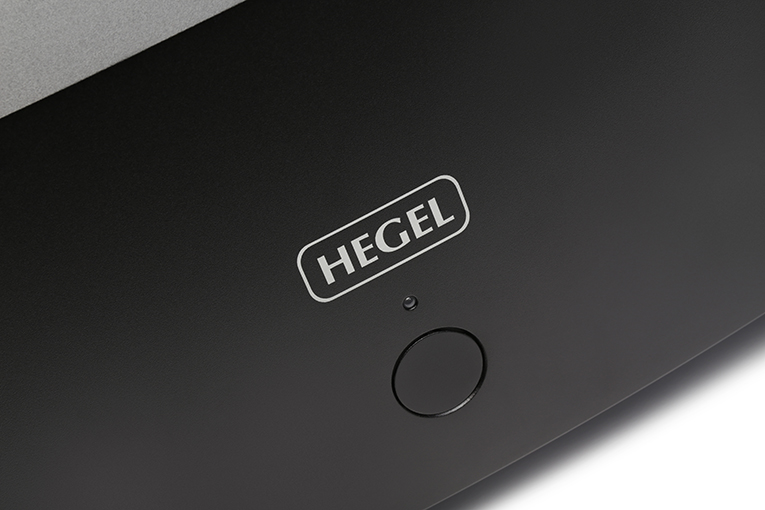
Over the last couple of years, I’ve had three amplifiers with similar power ratings in my system: the Bryston, the Simaudio, and this here Hegel. At 300, 225, and 300Wpc respectively, all three could be considered high-powered, but power doesn’t tell the whole story. The Simaudio and Hegel are both bruisers, weighing around 100 pounds each, and the $20,000 Simaudio clocks in very close in price to the Hegel. The Bryston is lighter; and unlike the Moon and Hegel, isn’t really billed as a drives-any-load amplifier. The Simaudio stands out due to its ambitious coachwork—all panels are made from thick, milled aluminum. But at the end of the day, none of those parameters would drive my buying decision. An amplifier has one real job: it has to sound good. All three of these amps do that, but the Hegel did it best.
In looking back over this review, I note how effusive I’ve been about the Hegel Music Systems H30A. I’m a little bit uncomfortable with all this praise because it’s part of my job to try to find something to bitch about. Well, other than the fact that I can’t afford to buy it right now, and it’s hard to move when I want to dust underneath it, the H30A hits all of my musts, wants, and needs. I can’t really find anything about this amplifier that’s even remotely unsatisfactory. This doesn’t happen very often.
. . . Jason Thorpe
jasont@soundstagenetwork.com
Associated Equipment
- Analog sources: VPI Prime Signature turntable; EAT Jo No8, DS Audio DS 003 cartridge.
- Digital source: Logitech Squeezebox Touch.
- Phono stage: Aqvox Phono 2 CI, iFi Audio iPhono 3 Black Label, Hegel Music Systems V10, DS Audio DS 003, EMM Labs DS-EQ1, Meitner DS-EQ2.
- Preamplifier: Sonic Frontiers SFL-2 Hegel Music Systems P30A.
- Power amplifier: Bryston 4B3.
- Integrated amplifier–DAC: Hegel Music Systems H120, Eico HF-81.
- Speakers: Focus Audio FP60 BE, Estelon YB, Aurelia Cerica XL Estelon XB Mk II.
- Speaker cables: Audience Au24 SX, Nordost Tyr 2.
- Interconnects: Audience Au24 SX, Furutech Ag-16, Nordost Tyr 2.
- Power cords: Audience FrontRow, Nordost Vishnu.
- Power conditioner: Quantum QBase QB8 Mark II.
- Accessories: Little Fwend tonearm lift, VPI Cyclone record-cleaning machine, Furutech Destat III, Musical Surroundings Fozgometer azimuth meter, DS Audio ION-001 Vinyl Ionizer.
Hegel Music Systems H30A Stereo/Mono Amplifier
Price: $19,000.
Warranty: Two years, parts and labor.
Hegel Music Systems AS
PO Box 2, Torshov
NO-0412 Oslo
Norway
Phone: +47 22-60-56-60
Fax: +47 22-69-91-56






















